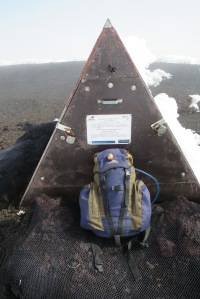Hekla is one of the most active volcanoes in Iceland: it erupts roughly every 10 years, usually with very little warning, and is long overdue. When driving along the ring road, it appeared that the summit was free from snow, so a plan was hatched to get to the top. Given that Hekla is close to 1500m high, and the snowline everywhere else appeared to be around 1000m, we maybe should have guessed that – perhaps – we hadn’t identified the correct mountain. Sure enough, when the proper Hekla appeared it looked very white indeed – but given that we had a good weather window, I opted to give it a go anyway to see how far I could get.
The next problem was that the approach to the base is 16km along a 4WD-only track which was shut. An obvious solution presented itself.
I managed 11km on two wheels before hitting the first snow field and continuing on foot. As I went higher, the snow patches became more widespread, but every time I started to think that maybe this wasn’t very sensible and I should turn round, an extensive patch of bare ground would appear to get me a bit further up. It became clear that, on one side of the ridge it was (sort of) summer whilst the other side looked considerably more wintery.
The crux was a section at about 900m altitude that looked very steep and entirely snow covered, but I found a barely consolidated tephra pile that was much better for getting up the steep bit. From there the route was completely white, but the gradient was much more reasonable and I didn’t sink in too much so I plodded on. It is a measure of the conditions that the only other people I saw on the mountain all day were driving snowmobiles.
Eventually, I came across the University of Palermo’s gas analyser and declared this to be The Top and worthy of a suitable reward.
A few days later, the weather broke and we were treated to lashing rain and wind. A perfect day to go underground – so that’s what we did. Vatnshellir is a short lava tube on the Snæfellsnes peninsular that is open for guided tours.
Although formed in a completely different manner to limestone caves, many of the features look very similar. It was very odd to see a black “stalagmite” that was formed by molten lava squeezing up through the solidified crust – and took about an hour to form rather than several thousand years. There was inevitably a feature that was supposed to look a bit like a troll’s face – we don’t have a photo, but it looked a bit like this.
The tip of the Snæfellsnes peninsular is one big lava field, and if you wander round for long enough you will eventually stumble across plenty of lava tubes by yourself. There are also many old craters knocking around, and the whole effect looks suitably primeval. Julia has declared that she likes lava and has to be dissuaded from overloading our van with too many samples.
In conclusion, if you like igneous rocks, you really ought to visit Iceland. Coming here has reminded me why I was so much more keen on hard rock than soft rock geology back in the day. Rocks formed from ash and lava exploding out of the ground versus rocks formed from sand settling on the bottom of a pond: which sounds more exciting to you?









The obvious question is: why does the gas analyser have a plug dangling from the top?
LikeLike
Good question – I hadn’t spotted that. It doesn’t look very weatherproof…
LikeLike